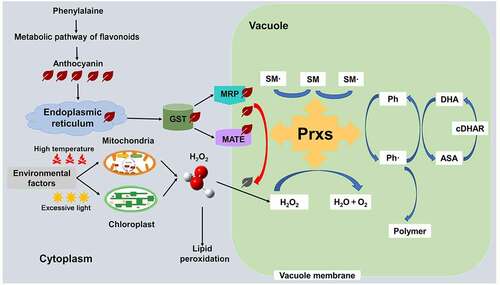Figures & data
Figure 1. Class III peroxidases (Prxs) in the vacuoles coupled with H2O2 oxidation to promote the degradation of anthocyanin. Anthocyanins are synthesized in the cytoplasm by phenylalanine through flavonoid metabolic pathways and are then transported to the vacuoles through further processing in the endoplasmic reticulum. Anthocyanins are transported into the vacuoles by anthocyanin transporter including glutathione S-transferase (GST), multidrug resistance-associated proteins (MRPs) and MATEs (multidrug and toxic compound extrusion transporters). However, anthocyanin is easily degraded due to high temperature or excessive light stress after entering the vacuole. The main manifestation was the increase of H2O2 content. Excessive H2O2 entered the vacuole leads to a coupled oxidative reaction Prxs and anthocyanin resulting in the degradation of anthocyanin. Besides, multiple cycles centered on Prxs were formed under these stress conditions to maintain the balance of H2O2 in plants.For one thing, Prxs oxidize secondary metabolite substrates (SM) to secondary metabolite radicals (SM·). For another, Prxs oxidize phenol compound (Ph) to phenolic radical (Ph·), and oxidize ascorbic acid (ASA) to monodehydroascorbate (MDHA), MDHA will spontaneously interact to produce dehydroascorbic acid (DHA), which can be reduced to ASA through cytosolic dehydroascorbic acid reductase (cDHAR) of cytosolic, thus forming a synergistic cycle of Prxs/Ph/AsA and H2O2.

